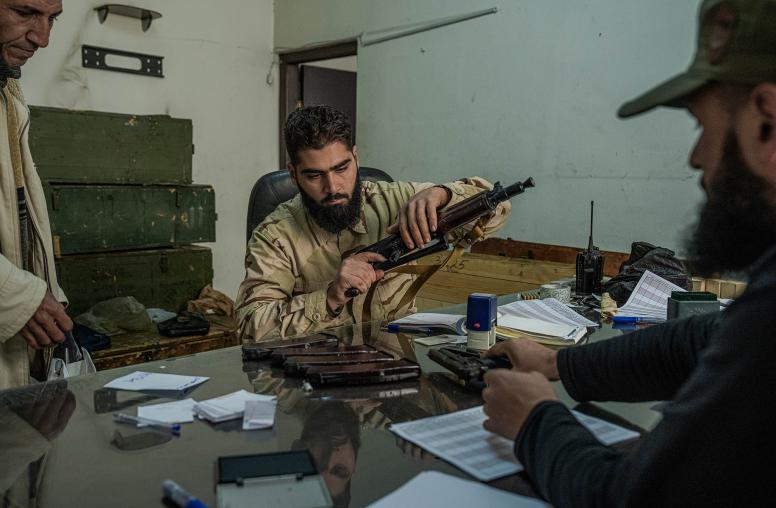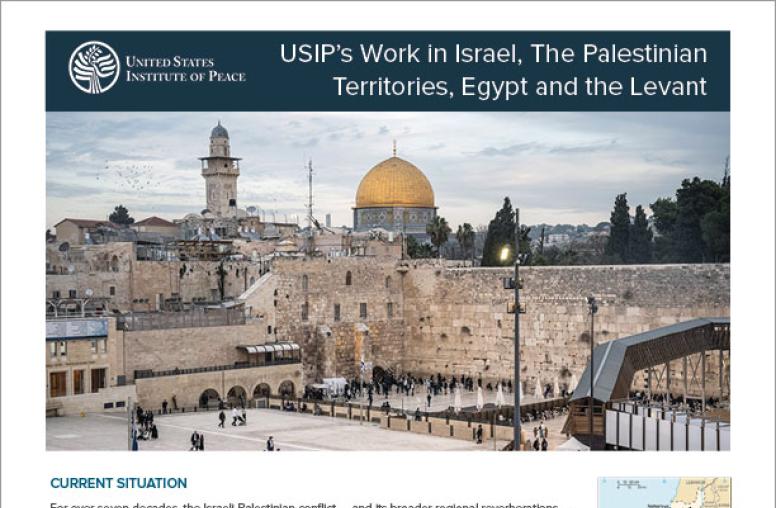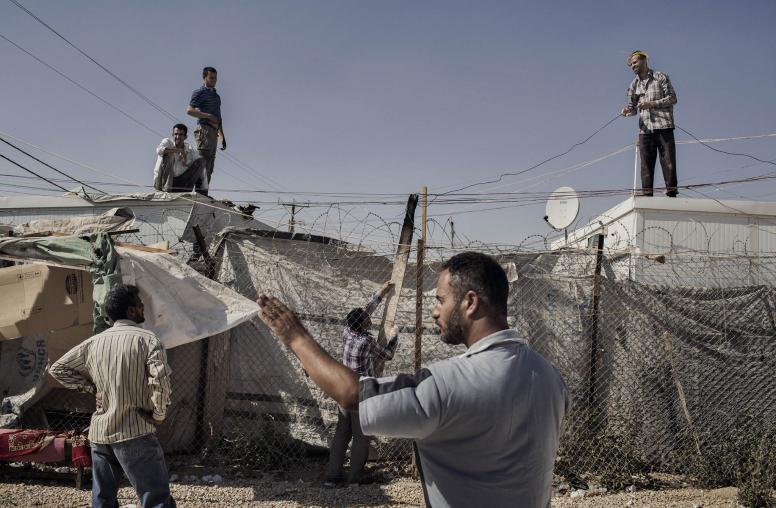A Month After U.S. Withdrawal, What is the State of Play in Syria?
The complicated conflict has become even more complex, with no solution in sight.
In the month since President Trump’s October 6 phone call with Turkish President Erdogan and the announced U.S. withdrawal from northeast Syria, the picture on the ground has changed immensely. Moscow has emerged as the key power broker in Syria. The Kurds, looking for protection from Turkish forces, are in Russian-brokered talks with the Assad government. These discussions could pave the way for an expanded Syrian government presence in the northeast for the first time in years. Successive agreements with Turkey negotiated first by the United States (October 17) and then by Russia (October 22) to halt Ankara’s fighting with the Kurds have been marred by violations.

In Geneva, a constitutional committee comprised of government, opposition and civil society representatives has convened to draft a new constitution, an important step toward reaching a “Syrian-owned and Syrian-led” agreement to end the war. Meanwhile, the killing of ISIS leader Abu Bakr al-Baghdadi has overshadowed the real dangers of the terrorist group’s resurgence. USIP’s Mona Yacoubian examines this complicated picture.
What is going on in northeast Syria a month after the U.S. decision to withdraw and how are the Kurds faring?
Northeast Syria is witnessing ongoing violence as various forces—Turkish-backed Syrian Arab militias, Kurds, and Syrian regime troops—jockey for control over contested areas. While there has been loose adherence to the October 22 agreement negotiated between Russia and Turkey, continuing clashes underscore the persistent danger to civilians.
Per the agreement, Kurdish forces have redeployed 20 miles back from the border. Yet, Turkey stands accused of seeking to expand its control beyond the agreed parameters, provoking clashes between Kurdish and Assad regime forces and Turkish-backed Arab militias. Turkish-backed forces have probed near the town of Tel Tamer, outside the delineated zone, prompting a strong Kurdish and Syrian government military response. Meanwhile, a November 2 car bomb attack in Tel Abyad killed 13 people. While unclaimed, the attack has raised fears of either an incipient Kurdish insurgency or a renewed ISIS presence in the area.
Taken together, these developments signal a period of protracted instability in northeast Syria. Violence is likely to continue amid lingering uncertainty surrounding the Russian-Turkish agreement and its implementation and enforcement. Turkish, Kurdish and Syrian forces will continue to probe and repel as each seeks to gain advantage. Joint Russian-Turkish patrols have started, but Turkish President Erdogan continues to complain Kurdish forces have not fully withdrawn.
The Turkish president has also vowed to return 1-2 million Syrian refugees from Turkey into northeast Syria. However, most of these refugees are not from the northeast, setting the conditions for new conflicts to erupt. The possible re-introduction of U.S. forces to secure oil fields in a zone from Deir ez-Zor to Hasakeh could add yet another complicating factor, potentially leading to a U.S. confrontation with any of the array of forces currently battling on the ground.
What are the prospects for the constitutional committee recently launched in Geneva given the preponderance of external forces who are influencing events?
The constitutional committee is an outgrowth of the “road map for a peace process” established by U.N. Security Council Resolution 2254, which enshrines the key elements of a “Syrian-led” peace process to end the Syrian war. Known as the Geneva process, several rounds of talks have been held over the past several years with no significant breakthroughs. The recently-launched constitutional committee—which took nearly two years to establish—is comprised of 150 members, 50 each from the Syrian government, the Syrian opposition, and Syrian civil society. They are charged with drafting a new Syrian constitution as part of the Geneva process.
Unfortunately, the Geneva process continues to be overtaken by events on the ground. In this case, the U.S. decision to withdraw from northeast Syria, followed by the Russian-Turkish agreement on control of this region casts doubt on whether the constitutional committee can advance an inclusive and genuine “Syrian-owned” solution. Notably, Syrian Kurds affiliated with the Syrian Democratic Council, the civilian counterpart to the Kurdish-led Syrian Democratic Forces (SDF), have no representation on the committee.
Moreover, given the outsized role of external actors in Syria, especially Russia, a truly Syrian-led and owned process is a distant prospect. As the constitutional committee was set to convene, Russian Foreign Minister Sergei Lavrov (along with his Turkish and Iranian counterparts) visited Geneva, signaling Moscow's intent to influence the U.N. process in a direction that favors a Russian-defined political settlement. Russia seeks international legitimacy for the facts it has helped create on the ground inside Syria.
Beyond the role of Russia, Turkey, and Iran, an asymmetry of power between the Assad regime on the one hand and civil society and opposition elements on the other further undermines prospects for genuine constitutional reforms. Both factors—external powers and an unrepentant Assad regime—suggest that opposition and non-government actors on the committee will not be able to influence the trajectory of the conflict in a meaningful way.
ISIS has taken two major blows in recent weeks with the death of its leader and the capture of his sister. What are the broader implications of the developments of the last month for the terrorist group?
The death of ISIS leader Abu Bakr al-Baghdadi constitutes a significant setback for the group. The U.S. raid on al-Baghdadi’s hideout in Syria’s northwest Idlib province included the capture of other ISIS operatives and a potential trove of intelligence on the group’s strategy and operational plans post-caliphate. The killing or arrest of other key figures, including al-Baghdadi’s family members, could undermine the group further.
However, ISIS has proven itself to be resilient and adaptive to setbacks. Its decentralized structure and reliance on inspired attacks could further insulate the group from the loss of its one-time leader. The group has already announced al-Baghdadi’s successor, Abu Ibrahim al-Hashemi al-Qurayshi.
Ongoing instability in Syria’s northeast could also facilitate an ISIS resurgence. The current turmoil has disrupted the Global Coalition to Defeat ISIS’s important efforts to stabilize areas liberated from ISIS. Stabilization programming—restoring essential services such as water and electricity, refurbishing schools, and building the capacity of local governance—is essential to achieving ISIS’s enduring defeat. A lapse in stabilization programming could provide opportunities for ISIS to re-emerge.
While the SDF is a pragmatic partner that appears willing, in the short term, to continue its partnership with the United States to fight ISIS, the durability of this cooperation is in question given the pressures of the Turkish incursion and the return of the Assad regime in parts of eastern Syria.
In addition, more than 10,000 ISIS fighters are currently being guarded by Kurdish forces in a series of makeshift prisons. Never well-secured, these prisons are potentially more susceptible to ISIS prison breaks should Kurdish guards be pulled away to fight additional battles against Turkish-backed militias.


